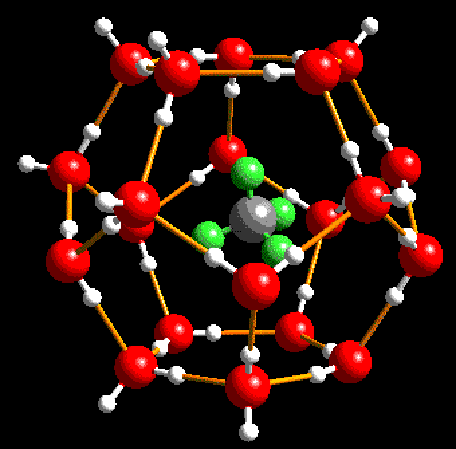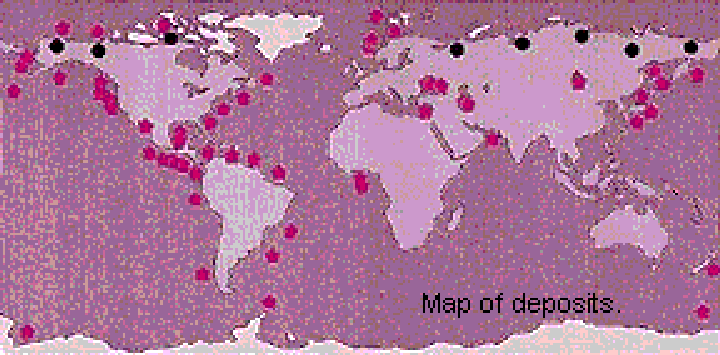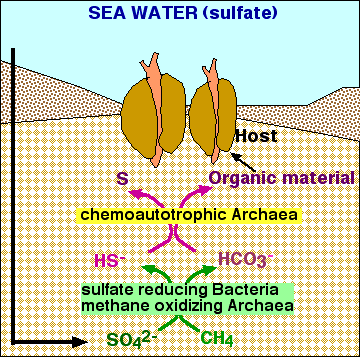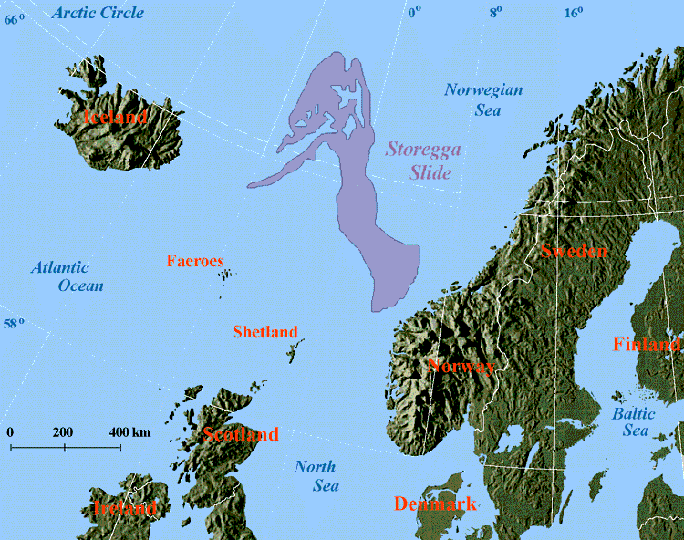Methane hydrates
(Clathrates):
![]()
New Fuel or Major Threat for
Increased Global Warming, Huge Slumps and Disastrous Tsunami?
Methane hydrates
(Clathrates):
![]()
New Fuel or Major Threat for
Increased Global Warming, Huge Slumps and Disastrous Tsunami?
Clathrates are also called gas hydrates. Hydrates were discovered in 1810 by Sir Humphrey Davy, and were considered to be a laboratory curiosity. In the 1930s clathrate formation turned out to be a major problem, clogging pipelines during transportation of gas under cold conditions. Gas hydrates, also called clathrates, are crystalline solids which look like ice, and which occur when water molecules form a cage-like structure around smaller 'guest molecules'. The most common guest molecule in natural hydrates is methane, CH4. In this figure the methane is shown by grey (carbon) surrounded by foor hydrogen atoms (green), trapped in a cage of water molecules (oxygen red, hydrogen white).

If all cages would be occupied by methane, one cubic meter of solid hydrate could contain 170.7 m3 of methane gas at standard conditions of temperature and pressure; in reality, usually up to about 164 m3 is present.
Recently clathrates have received attention as a possible energy source, and as playing a role in large undersea slumps which could result in dangerous tsunamis, as well as in climate variability.
What is the origin of the methane in clathrates?
The methane in gas hydrates is dominantly generated by bacterial degradation of organic matter in low oxygen environments. Organic matter in the uppermost few cm of sediments is first attacked by aerobic bacteria, generating CO2, which escapes from the sediments into the water column. This production of methane is a rather complicated process, requires the activity of several varieties of bacteria, and a lack of oxygen. In some regions (e.g., Gulf of Mexico) methane in clathrates may be at least partially derived from thermal (heat) degradation of organic matter, dominantly in petroleum. Below the zone of solid clathrates, large volumes of methane may occur as bubbles of free gas in the sediments.
Where do clathrates occur naturally?
Clathrates occur wherever it is cold enough, and/or the pressure is high enough, to make solid ice with methane inside, so where there is enough organic matter that can be used by bacteria. Because of the requirements of pressure and temperature, and because of requirement of relatively large amounts of organic matter for bacterial methanogenesis, clathrates are mainly restricted to two regions: 1. high latitudes (permafrost) and 2. along the continental margins in the oceans.
|
|
|
In polar regions the gas hydrates are commonly linked to permafrost occurrence onshore and on the continental shelves. In the oceans, gas hydrates are found on the outer continental margins, where the supply of organic material is high enough to generate enough methane, and water temperatures are close to freezing.

The average thickness of the clathrate stability zone along continental margins is about 300 m. The depth of its lower boundary is determined by the geothermal gradient: at greater depths in the sediment, the temperature becomes too high for gas hydrates. In general, gas hydrates are stable at water depths between about 300-400 m and 2500 m.
What
organisms
use clathrates?
In many regions where clathrates are present close to the sea floor (such as the Gulf of Mexico, offshore Oregon) there are large, dense communities of animals which are similar to the communities live close to deep-sea hydrothermal vents. But the communities living on hydrates live in a cold environments, and have been called 'cold seep' commnuities. The large organisms, as in hydrothermal vent communities, all live on prokaryotes (Archaea and Bacteria), either using them as symbionts or eating them. The prokaryotes live in complex commumities, where Archaea oxidize methane (from the gas hydrates), while Bacteria reduce sulfate from sea water to sulfide. The sulfide is then used by chemosynthetic bacteria.

How much clathrates are there?
The extent of worldwide gas hydrate occurrences in the oceans has been evaluated using seismic exploration, as is used for oil exploration. The oceanic reservoir has been estimated to be about 10,000 to 11,000 GtC (that is, Gigaton of carbon). This is more than twice as much as all other, recoverable and non-recoverable, fossil fuels (see below). Note, however, that there is very much uncertainty about the amount present, with estimates ranging between as low as 400 to as high as 20,000 Gt. Even the permafrost reservoir is on the order of hundreds of gigatons, not much smaller than the total amount of carbon in the terrestrial biosphere.
Sizes of organic carbon reservoirs (Kvenvolden, 1998); figure from USGS website.

To express this enormous amount in different units, we can say that estimates vary widely: globally 600,000 to 2,000,000 Tcf (trillion cubic feet). One trillion cubic foot of gas is about equal to 1 quadrillion Btu (quad). It becomes clear how huge the gas hydrate reservoir is if we consider that world energy use per year in 2000 was close to about 500 Quad = 500 Tcf hydrate gas: one could thus run the whole world on gas hydrates for a long time, IF it was possible to exploit the hydrates. Gas hydrates are abundant along the coasts of several countries that are poor in oil, such as Japan and India, so that there is much interest in gas hydrate exploration and exploitation.
In the last few years, many governments (including those of the US, Canada, Russia, India and Japan) have become very interested in possibilities of methane hydrates as fossil fuels. On 13 April 2000 the U.S. Senate authorised $47.5 million over five years for the Department of Energy to study methane hydrates: ice-like crystals of methane said to have the energy potential equal to more than twice that of all fossil fuels combined, and then-president Clinton signed the bill (Methane hydrate research and development act). These efforts of hydrate exploitation are in their first stages: Japan drilled a test hole in late 1999; now (spring 2006) both India and Japan are actively involved in dveeloping methane hydrate as a fuel. The methane in gas hydrates might be recovered through injection of hot water or depressurization, but the process might turn out to be technically difficult and thus expensive. The USSR tried unsuccessfully to recover gas hydrates from permafrost reservoirs in the 1960s and 1970s. We do not know enough about the ways in which the gas hydrates occur in the sediments to be able to plan for their recovery, because hydrates have been drilled at very few places. If gas hydrates mainly occur thinly dispersed in the sediments, they will be difficult to exploit. Ocean Drilling Program drilling on Blake Ridge (offshore to the east of Charleston), however, suggested that our estimates of the total volume of gas hydrates might be too low rather than too high, and that large volumes of free methane gas might occur below the solid hydrates. There are also risks involved in trying to recover the methane (see below). The recovery techniques will not be easy: drilling will heat up sediment, causing the ice to melt and the gas to escape (possibly blow up). It may be possible to adapt axisting technology (used to prevent 'blow-out' when drilling for oil. In addition, gas can not easily be used to replace oil: it must be highly compressed (with adherent danger) and liquefied, or is much too voluminous to transport. It can be used easily for heating and power generation, but must be reacted into larger-molecule hydrocarbons (like those occurring in oil) if it is to be used to fuel cars. Similar technology (needed to get smaller molecules to react into larger ones) is being developed for the use of biofuels.
Clathrates as a cause of tsunamis/climate change
During the formation of gas hydrates, methane and water become immobilized within the sediment pore spaces. Because of the presence of these solids (instead of pore waters and gas), the sediment can not become consolidated because the water can not be expulsed with increasing overburden as more sedimentation occurs. Cementation of the sediments does not occur when pore spaces are filled with hydrates (solid ice) rather than with water, from which minerals such as calcite can be precipitated. Gas hydrate rich sediments are thus cemented by the hydrateice, which may occupy much of the sedimentary section, but which are not stable when the temperature rises or the pressure falls (sea level falls). In general, rising temperatures have more effect than falling pressure. If temperatures of ocean waters rise, hydrates will no longer be stable, and will disintegrate into a liquid water and gas. This could lead to the development massive underseas landslides. With the landslides, more gas could escape. Several examples of possibly gas-hydrate linked extremely large slumps have been described, e.g., on the Norwegian continental margin, where debris from the giant, three-part Storegga slide, over 450 m thick, is spread over a distance of 800 km. One of the Storegga slides caused a tsunami to deposit sediment up to 4 m above the high water line in Scotland. There are more of these mega slides in the same region. We think that these slides were triggered when the ocean waters warmed by a few degrees at the end of the last ice age.

Methane is greenhouse gas, and discharge of large amounts of methane into the atmosphere would cause global warming. Methane is oxidized in the atmosphere (on average, its residence time is about 10 years) into CO2, which means that it will remain active as greenhouse gas, and is not removed from the atmosphere upon oxidation. It thus is clearly of importance that exploration and use of gas hydrates must be done ondr strict controls, in order to prevent additional global warming. Note that ongoing global warming already caused slight warming of ocean water at the depths that gas hydrates occur. Increased warming thus could trigger release of methane and thus cause more global warming (positive feedback). Methane released within sea water could also (at least in part) become oxidized within the oceans, and use up oxygen in the process. This would cause a lack of oxygen within the deeper waters of the oceans, which can not pick up oxygen from the atmosphere easily, and could be disastrous for ocean life (see lecture on mass extinctions).
There are MANY websites with information on gas hydrates; this link will get you to an inventory of sites.
